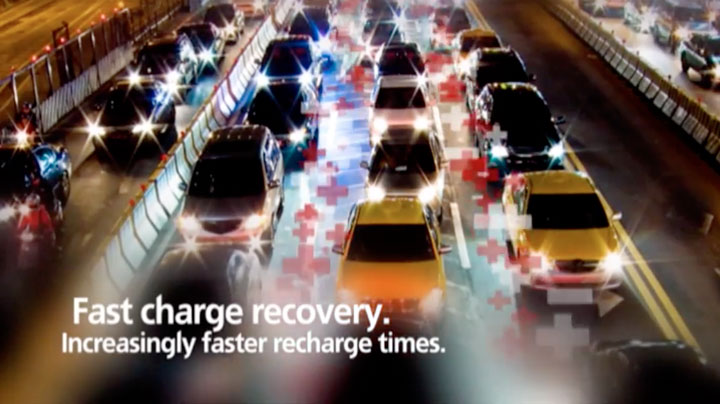INSTRUCTIONS FOR CORRECT STORAGE
Batteries must be stored and handled to always sell the oldest first according to the First In - First Out or "FIFO" principle.
DRY CHARGE BATTERIES
No particular precautions are needed. The product can be stored for up to 18 - 24 months in a suitable envi- ronment (temperature possibly in the range from 0 C to 40 C, no excessive humidity) without being subject to alterations.
FLOODED BATTERIES
"Maintenance-free and/or low maintenance" flooded batteries have good charge preservation features (low self-discharge) and can be stored in appropriate conditions for 6 - 8 months from the last charge date at am- bient temperature in the range from 0 C and +25 C.
INSTRUCTIONS FOR COMMISIONING
FLOODED BATTERIES
The battery is ready for use and may be installed directly on the vehicle. For batteries with the "Check Con- trol", the indicator must be green. If it is dark, recharge the battery until it turns green (battery charged).
Check that the terminals are clean. Clean with a brush or other suitable tool, if needed.
On batteries with "Check Control" the indicator will turn bright white if the electrolyte level is too low: re- place the battery without attempting to top it up or recharge it. See example of label on battery lid indicating " Check Control " states.
SAFETY RULES
Batteries contain sulphuric acid (corrosive) and emit explosive gas, particularly during recharging. Observe the precautions required in law. For example, in Italy, Legislative Decree 81/08 - art. 74 requires the use of personal protection equipment (PPE) to carry out operations on batteries (gloves, eyewear, suitable clothing etc.).
Danger while handling live batteries.
Never place and/or leave metallic objects on the battery: they could come into contact with the two terminals and cause a short circuit with explosion of the battery. Always connect the positive terminal (+) terminal first when installing a battery on a vehicle.
Always disconnect the negative (earth) terminal (-) first when removing a battery from a vehicle.
Keep the battery away from flames, lit cigarettes and avoid sparks.
Clean the battery with damp antistatic cloths (never use wool, never use dry cloths) a few hours after ending the recharging operation to make sure that the produced gases have had time to be completely dispersed into the air.
Use the indicated PPE: face protection, gloves, acid-resistant clothing.
Use absorbent material to restrict spillage of acid.
Do not lean over a working battery or during installation and removal operations.
DISPOSAL OF EXHAUSTED BATTERIES
Starter batteries contain lead and are consequently classified (in Italy pursuant to DPR 915/92) as toxic harmful waste. For example, in Italy they must be collected at a listed National Battery and Accumulator Register cen- tre. These centres are the only ones authorised to collect waste batteries free of charge and dispose of them correctly (Art. 118, subsection 3, item B, D.Lgs 152/06 and amendments - Art. 7, subsection 5, D.Lgs 188/2008).
NEVER throw batteries away with normal rubbish. For more information on battery recycling, please check your local legislation before disposal.
REPLACING START&STOP BATTERIES
Batteries for cars equipped with Start&Stop system must only be replaced with Start&Stop batteries taking care to always use the technology originally installed by the manufacturer:
• AGM -> AGM
• AFB/EFB - > AFB/EFB
Watch the VIDEO on Start&Stop batteries and their installation procedure.
Look at the SHEET on the guide for choosing the right Start&Stop battery.
For some cars, in addition to the indispensable diagnostic system, you may be asked to enter some codes.
Access through this LINK to the application (registration is required) to obtain the necessary codes.
RELEVANT EUROPEAN STANDARD
DESCRIPTION OF THE SPECIFIC CHARACTERISTICS OF START&STOP BATTERIES
European Standard 50342-6 2015 is applicable to lead-acid batteries with a nominal voltage of 12 V, mainly used in motor vehicles as an energy source for starting internal combustion engines (ICE), the batteries included in the field of application of this standard are used for so-called micro-cycle applications, called Start-Stop applications (or Stop-Start or Stop and go, etc.). Micro-cycle batteries are individually designed for each type of vehicle. Therefore it is important that any spare part operator is able to choose the appropriate battery for the car, otherwise the S&S system functionality and the reliability of the battery will be negatively affected.
BATTERY IDENTIFICATION
From the end of 2018, all Starter batteries (SLI and S&S) may therefore indicate, in addition to the mandatory characteristics according to the standard EN - Battery Regulation 1103/2010 (voltage [V], Capacity [Ah] and Starting attitude [A]), also the performance indexes that identify the level or class of performance according to the technical standards EN 50342-1 2015 and EN 50342-6 2015.
Watch the VIDEO about the European Standard EN 50342:2015.
| Performance index | Meaning | Levels | Requirements |
| W | Water consumption | from W1 to W5 | The minimum requirement is W2 to be declared with Low Maintenance/Without Maintenance |
| C | Cherge retention | from C1 to C2 | The requirement is C2 for any Start&Stop battery |
| V | Resistance to vibrations | from V1 to V4 | The requirement is V3 for Super Heavy Duty batteries |
| E | Endurance to cherge/discharge cycles | from E1 to E4 | The requirements is E1 for conventional batteries for cars and light commercial vehicles |
| M | Performance for Start&Stop microcycles | from M1 to M3 | Specific fo Start&Stop batteries, for the AGM technology the requirents is M3 |
















